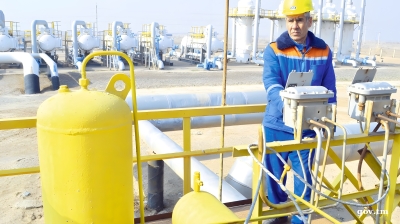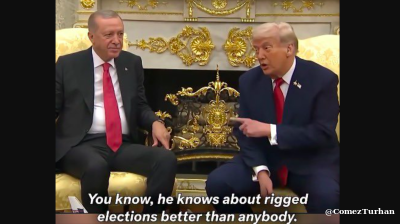Iran has somewhere between 5,000 and 6,000 naval mines, according to US intelligence estimates, which it could use to block the Straits of Hormuz and halt the flow of a fifth of the world’s oil traffic in a week.
An analysis written by bne IntelliNews’ sister publication Newsbase, which covers global energy issues, concluded that Iran could seed the straits with mines at any time of its choosing. Gulf oil production for export would stop almost immediately after Tehran declared that Hormuz was mined. As the storage facilities in the Gulf are limited, as the buffers back up, oil producers that depend on the ports on the Gulf to export crude would have to cap their wells and stop production.
Even a small number of mines would stop tanker traffic through Hormuz immediately, as global insurers would demand that tankers either turn around or, if already in the Persian Gulf, immediately drop anchor rather than risk hitting a mine.
Once Iran declared the strait mined, the delay while a Western alliance was formed would allow the Islamic Republic to continue to sow mines at a rate of up to 100 per day until the key channel was impassable, according to military experts interviewed by Newsbase.
The Gulf Cooperation Council (GCC) countries would likely immediately declare a Total Exclusion Zone, accompanied by a complete closure of its members’ ports to small traffic, but the US naval presence in the Gulf is limited and the GCC has no effective means of preventing minelaying by Iranian submarines. Once the focus of the war shifts to shipping in the Gulf, Iran’s mine stocks and submarine fleet are large enough to support the mining campaign, possibly for as long as six months.
“If Iran decides to close Hormuz with mines, it will definitely succeed in its aim in the short term. Absent a major shift of policy towards pre-emptive action, the West cannot stop Iran from initiating a mining campaign in the Gulf,” says Gav Don, a former British naval officer and the author of the Newsbase analysis. “The threat to global oil supplies from an Iranian mining campaign is therefore material, and would be effective.”

Mine types
Sea mines come in three types – ground mines, moored mines and rising mines. Ground mines are simply large explosive charges (of up to a few hundred kilos) which lie on the sea-bed waiting for their target to pass over them. Moored mines are explosive charges which float in the sea at a pre-set depth, moored to a sinker on the seabed. Rising mines are mines which, once triggered, can move towards their target, generally in the form of a supercavitating underwater rocket.
All mine types are equipped with sensors which trigger the mine when they detect a target’s pre-programmed magnetic, acoustic or pressure signature.
Modern mines can be given a “ship count”, which will programme them to ignore “n” targets and kill the “nth+1” target. Ship counts are a major obstacle to minesweeping tactics that rely on decoys to set them off.
Mines can be laid in a dormant state, set to go live at a specific time, or on a specific sonar or radio command (if they are laid shallow enough to receive radio signals). Sophisticated designs can be programmed to switch on and off in a pre-planned cycle, or on command to allow friendly traffic to pass unhindered.
Because mines need to be beneath the ship when they go off to do any damage, the effective area of water covered by a mine is approximately 6,500 square metres. This limitation means that in wide waters (Hormuz is wider than the English Channel) many tens of thousands of mines would be needed to create a physically effective barrier to shipping.
Submarine minelaying
As of mid‑2025, Iran appears to operate approximately 25 submarines, including a mix of attack, coastal, midget and domestically built models.
Included in the fleet are three Russian-built Kilo class diesel-electric submarines and about 20 Ghadir‑class midget submarines.
The Kilo is the most capable and can be loaded with twenty mines. Each Ghadir can lay four mines via torpedo tubes. However, the Ghadir has a relatively short range when in stealth mode, whereas the Kilo has 300-km range when using batteries, enough to cover the entire straits without having to reveal itself to recharge its batteries.
Before the threat of mines would be made public, Iran would employ normal smaller working ships to lay mines in large numbers very quickly. It is only once it announced the presence of the mines that the submarine fleet would come into its own.
“In short, while peace prevails, Iran has the capability to lay as many mines as it wishes, in whatever locations it wishes, at any time. In a Hormuz war, Iran would still have an effective way of laying mines to replace those swept by the Alliance,” says Don. “In practice, we believe that Iran would always send its Kilos to sea with some torpedoes as well (for self-defence), so in practice we would expect a Kilo to lay no more than ten to twelve mines on each mission.”
The Kilo is a diesel-electric submarine and has been featured in several movies such as “Crimson Tide” and “The Widowmaker”. When running on batteries at low speed (3 knots, or 75 miles per day) the Kilo is almost undetectable even to a sophisticated and well-handled sonar.
Navigable channels
While traffic is pinched in the Straits of Hormuz in the Persian Gulf, it remains a large body of water. The straits is approximately 33-km wide at its narrowest point. Nevertheless, the navigable shipping lanes are much narrower: each lane is 2 nautical miles wide (about 3.7 km), separated by a 2-nautical-mile buffer zone. So the total effective channel used for tanker traffic is about 6 nautical miles (11 km) across.
Hormuz traffic is currently organised into a single narrow Traffic Separation Scheme (TSS) with two lanes and a buffer between them, whose locations and size have been selected to give large tankers the maximum possible space in which to manoeuvre, and the smallest possible number of corners to turn.
Laying mines in the TTS is an obvious strategy; however, once mines are laid shipping can and will sail outside them in what are still navigable waters.
The first days and weeks of an Iranian maritime war would see Hormuz and its approaches more or less empty of shipping, apart from those tankers which chose to stop and anchor rather than risk carrying on to the open sea.
“Insurers will immediately tell owners of both ships and cargoes that insurance within Hormuz is suspended for any tanker that is not at anchor, making the decision to stop and anchor inevitable,” says Don. “The straits will immediately become a no-go zone even if the Iranian mines are thinly dispersed.”
On land the impact would be equally dramatic. Within the Gulf the withdrawal of insurance would have drastic consequences. The production of oil in large quantities is a “flow” system rather than a “batch” system. Tankers are part of that “flow.” If tanker traffic stops then it takes only one or two days at most for the buffer storage tanks at loading terminals to fill to capacity. Once they are full, it takes only another day or so for buffer storage back up to the wellhead to fill, and once all the buffer storage is full, oil production must of necessity stop.
“So within (at most) seven days of Iran announcing covert minelays, Persian Gulf oil production for export by tanker will cease,” says Don.
Within a week, an alliance drawn from the US, supported by the UK and many other partners including China, which is especially dependent on exports from the Gulf, as well as Nato, ASEAN, the Gulf Cooperation Council (GCC), the EU, and non-aligned states would form to try to reopen the straits.
That would take a little time to organise. The US Fifth Fleet, headquartered in Bahrain, still retains operational mine warfare equipment and trained personnel, but it has no permanently stationed minehunter ships in the Gulf. The Kingdom of Saudi Arabia (KSA) also has three British-made Sandown‑class minehunter vessels, and the UAE has two German-made Frankenthal‑class minehunters that could be deployed.
Mine clearance
The only way to reopen the straits would be to send in minesweepers and begin the painstaking task of clearing the mines, while Iran would switch to reseeding the straits using its fleet of submarines, thus keeping the straits unnavigable.
Newsbase estimates the Alliance would begin the campaign to clear Hormuz, with the capacity to clear 20 square kilometres per task day of the 250-km long channel at its narrow point, but the area that would need to be checked is much larger if Iran lays mines beyond the TSS channels. In theory, an alliance would be faced with clearing an area of over 10,000 square kilometres, according to Newsbase’s estimates, using only around eight vessels that are currently available.
However, the alliance could in theory open a safe corridor closer to the UAE coast in just over a week to get shipping moving again, although even then, persuading the insurance to allow traffic to flow remains a major obstacle to restarting oil flows, especially if weapons other than mines were brought into play.
Very quickly the question of widening the war and bringing Nato or US destroyers with anti-submarine capabilities would come up. With the secondmost powerful navy in the world, the US would face the choice of declaring war on Iran and deploying its fleet to the Persian Gulf to prevent Iran’s submarines from operating, to nip a major global energy crisis in the bud – a decision it seems very likely the White House would take.
Even then, the straits would remain closed for at least a month at the minimum, as mine clearing is a painfully slow process. Mine Countermeasures (MCM) can be addressed in two ways – “sweeping” and “hunting.” Sweeping has two subdivisions: influence sweeping and mechanical sweeping.
Developed in WWII, in influence sweeping, the MCM unit tows a decoy through the water that is designed to replicate the acoustic and magnetic signature of a ship. The idea is that this gear will deceive the mine into detonating in the wake of the MCM unit, whose own signatures are designed to be minimal, making them amongst the most expensive boats afloat.
Modern mines are much more sophisticated and probably won’t be detonated by influence sweeping, which is only effective against simple mines. Moreover, this tactic is effectively countered by the ship-counting mines that don’t blow up simply because something sails over them.
Allies may choose to influence sweep using helicopters instead (including the US MH-60S helicopters equipped with AN/AQS-20 sonar and mine disposal sleds), which also makes good TV. The US navy has also developed unmanned drones, such as the battery-powered Swordfish and Kingfish, to hunt mines, but this remains a young technology with limited resources deployed, according to reports.
Hunting mines is much more effective, but also very time-consuming. In mine hunting the MCM unit uses sonar to detect mines and mine sinkers on the seabed.
“Using a searchlight sonar may be compared to walking around Central Park in the dark trying to find a squash ball with a laser pointer with a range of only a few hundred metres – the job is slow, detailed and requires high levels of training and ultraprecise navigation,” says Don.
As sonar returns a low-definition signal, following any contact, an underwater rover with a camera has to be sent out to identify the contact as a mine before it is destroyed.
Staying within the law
Who can deal with Iranian sea mines in the Straits of Hormuz also raises several difficult legal problems. An Iranian mining campaign would be focused on the TSS to begin with, and its approaches and surroundings. Most of the mines laid would therefore be in the territorial waters of Oman and UAE, as well as some in Iranian waters as well.
“The law of war seems clear on this point – the laying of mines in Omani or UAE waters is an act of war against those two countries, and any mines aimed at commercial shipping, wherever they were laid, would also be illegal,” says Don. “The claim of “self-defence” is not open to Iran. But assuming that mines are laid in response to an Israeli attack on Iranian nuclear facilities, Iran would have a right of proportionate self-defence against Israel, but not against any other country.”
The problem is that an attempt to close Hormuz would not be aimed at Israel itself, and so would be classed under international law as an illegal act of aggression. But as that aggression would not be aimed at Israel, the US or any other great power, their right to act is limited. There are only three reasons one country can legally use force against or in another country: if that country has attacked you first; if the government invites your forces in; or if there is a UN resolution authorising force.
The UN Charter contains a clear means to legitimise the use of violence against Iran: a Security Council Resolution authorising UN members to use force to reopen Hormuz. If this Resolution could be obtained – and both Russia and China are allies of Iran and have vetoes – then the full scope of the developed world’s military force could be deployed under restraint only of the words “reasonable” and “proportionate”.
In a Hormuz war there would be no attack in either the US or Europe, and so NATO’s charter gives no legal foundation for NATO action in the Gulf.
The demonstrable victims of Iran’s hostile act – Oman and UAE – would be entitled to take reasonable and proportionately violent steps to defend their security under the UN Charter, but it is up for debate as to whether other members of the GCC would also be lawfully entitled to use violence against Iran, as there is no “self-defence” involved, only self-interests. Other countries such as the US, which had not been attacked, would probably not be legally entitled to attack Iran.
The UN Charter permits a state to use force to protect its security while the UN debates what steps should be taken, but the definition of what “security” here is remains a little vague. Moreover, there is a major argument over whether this right extends to “pre-emptive” acts, the basis used to justify Israel’s attack on Iran. Is US security threatened by a closed Hormuz or just its interests?
It seems certain that the US, the UK and possibly a handful of other countries would take immediate steps to task minehunters to begin clearing mines in Hormuz under the UN holding provision. The situation is made easier by the fact that minehunters and MCM units are fundamentally non-violent ships, working against material rather than people. They are barely armed, they are small and they are defensive in nature.
But this phase would be temporary, as minehunting alone cannot clear Hormuz because of continued re-mining by Ghadir submarines. To end the impasse a country such as the US would have to target and destroy Iran’s submarines, and that would mean bringing the US directly into the Israel-Iran war.
Features

Indonesia's $12bn stimulus play
The coordination between the Finance Ministry and the presidency signals tighter executive cohesion under President Prabowo’s leadership, contrasting with the cautious fiscal stance of prior administrations.

COMMENT: For Asia, dealing with Europe isn’t about achieving success; it’s about concealing failure
To be taken seriously in Asia, Europe must rediscover the courage to deliver, not merely declare. Asia has moved on to execution. Europe is still editing its initial policy draft.

Washington has a new focus on a Caspian energy play
For most of the last three decades since winning independence, Central Asia has been a bit of a backwater. Not any more. The Trump administration is becoming more focused on Turkmenistan's vast gas reserves and can smell money and power there.





